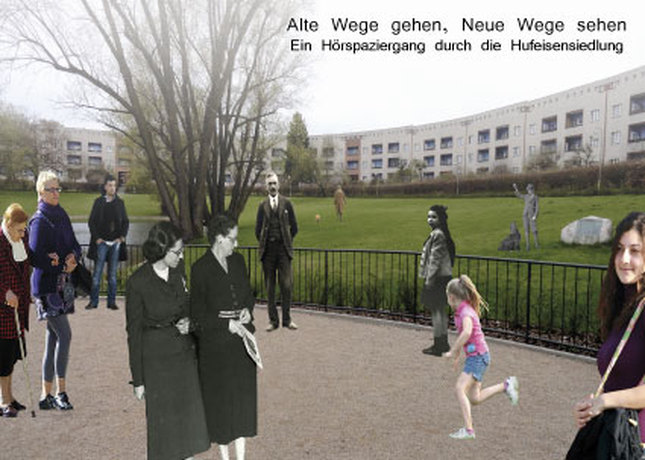_Roos Versteeg & Barbara Lenz (DEU), Alte Wege gehen, neue Wege sehen
#Local memory #History in a migrant society #Pluralistic experiences
1.09.13 at 13:00, Info Station Hufeisensiedlung, Fritz-Reuter-Allee 44, 12359
2 hrs, in German
Supported by Stiftung Erinnerung, Verantwortung und Zukunft. Partners: Neuköllner Kulturverein e.V., Museum Neukölln, Verein der Freunde und Förderer der Hufeisensiedlung.
Maximum group size: 14 people
Audience will collect a MP3 device and headphones at the starting point (an ID or passport deposit is required).
FB Event: https://www.facebook.com/events/1411740035704379/
How can the study of local memory be organized as an inclusive endeavour, open for everyone who is interested in history, and independently from his or her own regional identity/identities? How can local heritage be a part of a relationship with diverse memories and historical experiences that come together in a migratory society?
In spring 2012, we were invited by the Museum Neukölln to do a workshop with residents of Bruno Taut's Hufeisensiedlung in Berlin-Britz, which is listed by the Unesco as a World Heritage Site. The project was planned to be a part of the educational activities accompanying the museum's exhibition on the history of the residential area.
Aware of the lack of representation of the history of “migrants“ in the official memorial culture, we wanted to initiate a process of historical learning that takes into account pluralistic historical experiences composing the memory landscape of Germany today.
Therefore, we motivated people of diverse backgrounds to take part in the workshop, which aimed to study local culture from a transnational perspective. The special focus still lies on the history of the Hufeisensiedlung during National Socialism. In order to find answers to the difficult question: “Why do neighbours suddenly turn into enemies?” the group also looked at histories beyond local memory landscape.
The audio-tour reflects this whole encounter; through personal stories and memories, it recounts the history of the Huseiensiedlung before and after 1933, but also follows the reflections of Berliners with ties to Rwanda, Turkey and Bosnia.
In spring 2012, we were invited by the Museum Neukölln to do a workshop with residents of Bruno Taut's Hufeisensiedlung in Berlin-Britz, which is listed by the Unesco as a World Heritage Site. The project was planned to be a part of the educational activities accompanying the museum's exhibition on the history of the residential area.
Aware of the lack of representation of the history of “migrants“ in the official memorial culture, we wanted to initiate a process of historical learning that takes into account pluralistic historical experiences composing the memory landscape of Germany today.
Therefore, we motivated people of diverse backgrounds to take part in the workshop, which aimed to study local culture from a transnational perspective. The special focus still lies on the history of the Hufeisensiedlung during National Socialism. In order to find answers to the difficult question: “Why do neighbours suddenly turn into enemies?” the group also looked at histories beyond local memory landscape.
The audio-tour reflects this whole encounter; through personal stories and memories, it recounts the history of the Huseiensiedlung before and after 1933, but also follows the reflections of Berliners with ties to Rwanda, Turkey and Bosnia.
Roos Versteeg & Barbara Lenz
Speakers and collaborators: Achim Berger, Yeliz Borak, Fredi Diebel, Ingrid Hannemann, Jeannette Higiro, Heinz-Rudolf Meissner & Nikolina Skenderija
Barbara Lenz (*1975), M.A, has a degree in Anthropology and Cultural Studies. After completing her two-year traineeship (wissenschaftliches Volontariat) at the Berlin Ethnological Museum in 2007, Barbara started to work as an independent curator and project manager. She is specialized in realizing community based exhibition projects and interactive educational programs. Barbara´s work is inspired by the idea that collective thinking and joint creative action can intensify one´s relationship to him or herself and deepen the relationship to the people and environment that are surrounding us. Barbara is interested in initiating communication processes that connect people and their stories and that link the past to the present.
Roos Versteeg, (Rotterdam, 1979), has an M.A. degree in fine arts. After moving to Berlin in 2006 she started working on communal and interactive art projects, with varying groups. The artist guides them, sets the framework and invents a space for creation, encounter, experiment and play. The work consists of a mixture of workshops, temporary interventions, performance, installations and social sculptures. The main subject of the work is an intensified focus on daily living, and creating new of new possibilities of looking at and experiencing it. Roos mostly does this by copying and transforming familiar sociological systems, a good example is the artist's use of bureaucratic questionnaires.
Roos Versteeg, (Rotterdam, 1979), has an M.A. degree in fine arts. After moving to Berlin in 2006 she started working on communal and interactive art projects, with varying groups. The artist guides them, sets the framework and invents a space for creation, encounter, experiment and play. The work consists of a mixture of workshops, temporary interventions, performance, installations and social sculptures. The main subject of the work is an intensified focus on daily living, and creating new of new possibilities of looking at and experiencing it. Roos mostly does this by copying and transforming familiar sociological systems, a good example is the artist's use of bureaucratic questionnaires.

